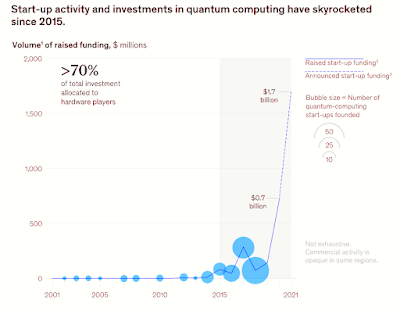One of the first basic quantum calculations utilizing individual molecules was accomplished in 1998 by researchers including Mark Kubinec of UC Berkeley.
They utilized radio wave pulses to flip the spins of two nuclei in a molecule, with each spin's "up" or "down" orientation storing information in the same way as a "0" or "1" state in a traditional data bit would.
The combined orientation of the two nuclei—that is, the molecule's quantum state—could only be maintained for short durations in carefully calibrated settings in the early days of quantum computers.
In other words, the system's coherence was soon destroyed.
Controlling quantum coherence is the last piece of the scalable quantum computer puzzle.
Researchers are now working on novel methods to generate and maintain quantum coherence.
As a result, ultra-sensitive measurement and information processing equipment will be able to operate in ambient or even severe circumstances.
Joel Moore, a senior faculty scientist at Berkeley Lab and a professor at UC Berkeley, received funding from the Department of Energy in 2018 to establish and lead an Energy Frontier Research Center (EFRC) – the Center for Novel Pathways to Quantum Coherence in Materials (NPQC) – to further those efforts.
"The EFRCs are a critical tool for DOE because they allow targeted inter-institutional partnerships to make fast progress on cutting-edge scientific issues that are beyond the reach of individual scientists," Moore said.
Berkeley Lab, UC Berkeley, UC Santa Barbara, Argonne National Laboratory, and Columbia University scientists are leading the way in understanding and manipulating coherence in a range of solid-state systems via the NPQC.
Their three-pronged strategy focuses on creating new quantum sensing platforms, building two-dimensional materials that host complex quantum states, and investigating methods to precisely regulate a material's electrical and magnetic characteristics via quantum processes.
The materials science community has the key to solving these issues.
Developing the capacity to control coherence in real-world settings requires a thorough knowledge of the materials that might be used to create alternative quantum bit (or "qubit"), sensing, or optical technologies.
Further advances that will contribute to additional DOE expenditures throughout the Office of Science are based on basic findings.
As the initiative approaches its fourth year, numerous scientific discoveries are setting the foundation for quantum information science advancements.
Many of NPQC's accomplishments so far have been centered on quantum platforms based on particular faults in a material's structure known as spin defects.
With the appropriate crystal backdrop, a spin defect may approach complete quantum coherence while also improving resilience and functionality.
These flaws may be exploited to create high-precision sensor systems.
Each spin defect reacts to minute changes in the environment, and coherent groups of defects may reach remarkable precision and accuracy.
However, it's difficult to grasp how coherence develops in a system with multiple spins that interact with one another.
To address this difficulty, NPQC scientists are turning to diamond, a common material that has shown to be excellent for quantum sensing.
Each carbon atom in a diamond's crystal structure is linked to four other carbon atoms in nature.
When one carbon atom is swapped with another or deleted entirely as the diamond's crystal structure develops, the resultant defect may act as an atomic system with a well-defined spin—an inherent type of angular momentum carried by electrons or other subatomic particles.
Certain imperfections in diamond, like these particles, may have an orientation, or polarization, that is either "spin-up" or "spin-down."
Norman Yao, a Berkeley Lab faculty scientist and an associate professor of physics at UC Berkeley, and his colleagues developed a 3D system with spins distributed across the volume by designing several distinct spin defects into a diamond lattice.
The researchers used that setup to create a method for probing the "motion" of spin polarization at very small length scales.
The researchers discovered that spin travels about in the quantum mechanical system in a similar manner as dye moves in a liquid, using a combination of experimental methods.
As recently reported in the journal Nature, learning from dyes has shown to be a viable route toward comprehending quantum coherence.
The multi-defect system not only offers a strong classical framework for understanding quantum dynamics, but it also provides an experimental platform for investigating how coherence works.
The NPQC platform offers "a particularly controlled example of the interplay between disorder, long-ranged dipolar interactions between spins, and quantum coherence," according to Moore, the NPQC director and a member of the team who has previously researched various types of quantum dynamics.
The coherence periods of such spin defects are highly dependent on their immediate surroundings.
Creating and mapping the strain sensitivity in the structure around individual flaws in diamond and other materials has been the focus of several NPQC discoveries.
This may show how to manufacture flaws in 3D and 2D materials with the longest feasible coherence durations.
But how could changes in the defect's coherence be related to changes imposed by pressures on the material itself?
To find out, NPQC scientists are working on a method for generating distorted regions in a host crystal and measuring strain.
"If you think of atoms in a lattice as a box spring, you get various outcomes depending on how you press on them," said Martin Holt, a principle scientist at NPQC and group leader in electron and X-ray microscopy at Argonne National Laboratory.
He and his colleagues provide a direct picture of the distorted regions in a host crystal using the Advanced Photon Source and the Center for Nanoscale Materials, both user facilities at Argonne National Laboratory.
Until recently, the direction of a defect in a sample was largely random.
The pictures show which orientations are the most sensitive, indicating that high-pressure quantum sensing is a viable option.
"It's amazing how you can take something as precious as a diamond and turn it into something useful.
It's fantastic to have something that's simple enough to grasp fundamental physics yet sophisticated enough to perform advanced physics "Holt said.
Another aim of this study is to be able to transmit a quantum state, such as a defect in diamond, from one place to another utilizing electrons in a coherent manner.
Special quantum wires that emerge in atomically thin layers of certain materials are studied by NPQC experts at Berkeley Lab and Argonne Lab.
The group headed by Feng Wang, a Berkeley Lab faculty senior scientist and UC Berkeley professor, and leader of NPQC's work in atomically thin materials, found superconductivity in one of these systems, a triple layer of carbon sheets.
"The fact that the same materials may provide both protected one-dimensional conduction and superconductivity offers up some new options for preserving and transmitting quantum coherence," Wang said of the research, which was published in Nature in 2019.
Multi-defect systems are essential for more than just basic science.
- They have the potential to be transformational technologies as well.
- NPQC researchers are investigating how spin defects may be utilized to regulate the material's electrical and magnetic characteristics in new two-dimensional materials that are opening the way for ultra-fast electronics and ultra-stable sensors.
Recent discoveries have thrown up some unexpected results.
According to Peter Fischer, a senior scientist and division deputy at Berkeley Lab's Materials Sciences Division,
- "Fundamental knowledge of nanoscale magnetic materials and their applications in spintronics has already ushered in massive changes in magnetic storage and sensor technology.
- Quantum coherence in magnetic materials may be the next step toward low-power devices, according to researchers."
The magnetic characteristics of a material are solely determined by the alignment of spins in neighboring atoms.
Antiferromagnets contain neighboring spins that point in opposing directions and essentially cancel each other out, unlike the perfectly aligned spins in a normal refrigerator magnet or the magnets employed in traditional data storage.
- Antiferromagnets, as a consequence, do not "act" magnetically and are highly resistant to external perturbations.
- Researchers have been looking for methods to utilize them in spin-based electronics, where information is carried by spin rather than charge, for a long time.
Finding a method to alter spin orientation while maintaining coherence is crucial.
In 2019, NPQC researchers led by James Analytis, a Berkeley Lab faculty scientist and associate professor of physics at UC Berkeley, and postdoc Eran Maniv discovered that applying a small, single pulse of electrical current to tiny antiferromagnet flakes caused the spins to rotate and "switch" their orientation.
As a consequence, the characteristics of the material may be fine-tuned very fast and accurately.
- "More experimental observations and some theoretical modeling will be required to understand the mechanics underlying this," Maniv added.
- "New materials may be able to provide light on how it works. This is the start of a new area of study."
- The researchers are now attempting to identify the precise process that causes the switching in materials produced and described at Berkeley Lab's Molecular Foundry.
Recent research published in Science Advances and Nature Physics suggests that fine-tuning flaws in a layered material may offer a dependable way to regulate the spin pattern in new device platforms.
Moore, the NPQC leader, stated, "This is a wonderful illustration of how having numerous flaws allows us to stabilize a switchable magnetic structure."
- NPQC will expand on this year's accomplishments in its second year of existence.
- Exploring how numerous flaws interact in two-dimensional materials, as well as researching novel types of one-dimensional structures that may emerge, are among the objectives.
- These lower-dimensional structures may be used as sensors to detect the smallest-scale characteristics of other materials.
Focusing on how electric currents may control spin-derived magnetic characteristics will also help to bridge the gap between basic research and applied technology.
Rapid success on these projects requires a unique blend of methods and experience that can only be developed in a big collaborative setting.
"You don't build capabilities in a vacuum," Holt said.
"The NPQC creates a dynamic research environment that propels science forward while also harnessing the work of each lab or site."
Meanwhile, the research center offers a one-of-a-kind education at the cutting edge of science, as well as chances to train the scientific staff that will drive the future quantum industry.
The NPQC introduces a new set of questions and objectives to the study of quantum materials' fundamental physics.
Moore said,
- "The behavior of electrons in solids is governed by quantum mechanics, and this behavior provides the foundation for most of the contemporary technology we take for granted.
- However, we are now at the start of the second quantum revolution, in which characteristics such as coherence take center stage, and knowing how to improve these features offers up a new set of material-related issues for us to solve."
~ Jai Krishna Ponnappan
You may also want to read more about Quantum Computing here.











